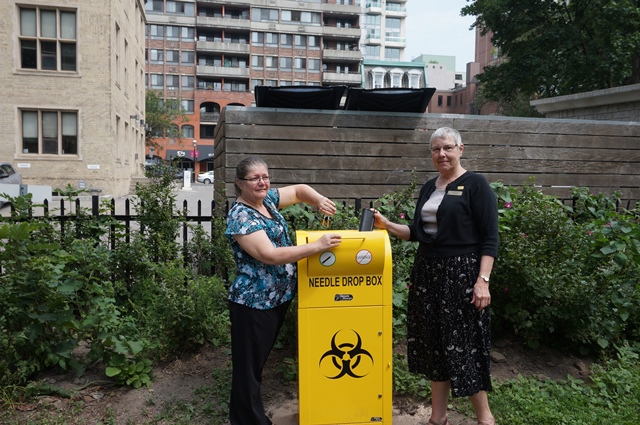
The unique skills of public health nurses are transferable to almost any area of nursing.
By Daniel Punch
In the shadow of St. James Cathedral’s 93-metre gothic tower, St. James Park is a welcoming patch of green among the grey concrete and orange brick of Toronto’s oldest neighbourhood. You can find a cross-section of downtown Toronto at the park. Bankers on lunch break, families towing babies and dogs, tourists, and clients of nearby homeless shelters all make use of the public space.
Unfortunately, you can also find an increasing number of used sharps left behind by opioid drug users. Between 30 and 50 sharps are left in the park every month, according to RN Lanadee Lampman, the St. James Cathedral parish nurse and a member of the Registered Nurses’ Association of Ontario (RNAO).
The used sharps are a health concern for the local community, St. James parishioners, and the handful of homeless people who spend their days in the park and sleep on the cathedral’s porch. “We’ve got dogs and babies and vulnerable people living here,” Lampman explains. “We need to deal with this.”
The solution came in the form of a big, yellow sharps disposal box. It sounds simple, but getting the box installed in the park required a year-long campaign that engaged community members and organizations, and made use of skills Lampman honed as a public health nurse more than 20 years ago.
Since graduating from the University of Toronto’s nursing program in 1984, Lampman has worked in nearly every health sector. She became St. James’ parish nurse in 2013. Her time as a public health nurse in North York in the early 1990s was particularly influential, she says, noting she’s carried the lessons she learned about community engagement throughout her career, and particularly into her current role.
Lampman first learned about the sharps disposal boxes at a Toronto board of health meeting in July 2016, where she was giving a deputation in support of supervised injection services. She soon joined the Toronto Needle Box Coalition, a group of concerned individuals and organizations seeking to get these boxes installed throughout the city.
Getting a sharps box in St. James Park required a lot of research and advocacy from Lampman. She partnered with Toronto Public Health’s (TPH) needle exchange program to help pay for the box and ensure its contents were disposed of. She reached out to local businesses and the neighbourhood association to calm their fears about the “scary looking box” she planned to install. She also did “show and tell” with the people who live in the park and clients of the nearby shelters. “I’m very noisy about my box, how to use it, and what it’s for,” she says.
The sharps box was finally installed on July 31, 2017. Though she still finds a few syringes in the park, more and more of them are being dropped in the disposal unit, which she checks once a month.
Unfortunately, the opioid epidemic continues to intensify in Toronto and across North America. In late July, one of the “regulars” at St. James died of an overdose. And in August, Lampman used her naloxone kit for the first time to prevent another overdose on the cathedral grounds.
To keep her community safe and healthy during the crisis, Lampman says she will continue to use a public health approach. She worked with TPH to educate St. James volunteers about harm reduction strategies, and is offering recovery support groups for people who have lost loved ones. “The focus on the wider community, working with groups, and connections are all things I learned from public health,” she says.
Daniel Punch is staff writer for RNAO, the professional association representing registered nurses, nurse practitioners, and nursing students in Ontario. This article was originally published in the Sept/Oct 2017 issue of Registered Nurse Journal, the bi-monthly publication of the Registered Nurses’ Association of Ontario (RNAO).

